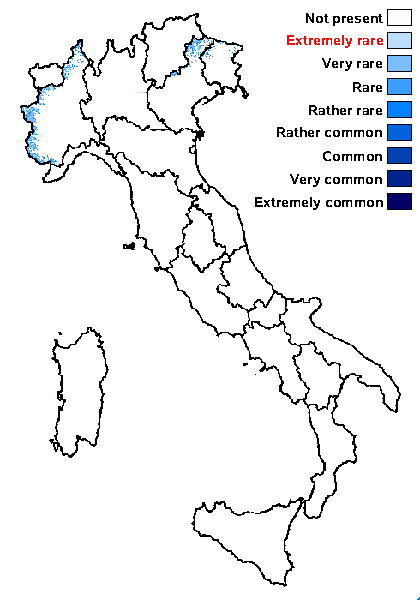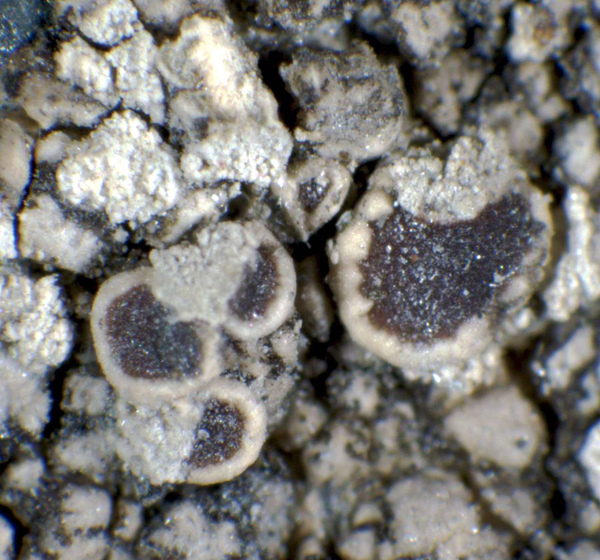Lecanora umbrosa Degel.
Bot. Not.: 105, 1943.
Synonyms: Lecanora neglecta (Räsänen) Räsänen; Lecanora sorediifera (Th. Fr.) Räsänen non Fée; Lecanora subfusca var. sorediifera Th. Fr.
Distribution: N - Frl, Ven (TSB 2042), Piem (TSB 34424). C - Sar (Rizzi & al. 2011).
Description: Thallus crustose, episubstratic, continuous or areolate-verruculose, whitish to yellowish grey, sorediate, sometimes delimited by a thin white prothallus, the soredia 25-50 µm in diam., arranged in confluent, white to yellowish white, flat to concave, 0.3-0.7(-1) mm wide soralia. Apothecia rather rare, lecanorine, sessile, (0.5-)1-2(-3) mm across, with a red-brown, mostly flat, epruinose disc and a persistent, entire or flexuose, smooth or partially sorediate thalline margin. Thalline exciple more or less distinctly corticate, with numerous algal cells, the medulla with small crystals partly soluble in K; proper exciple colourless, with crystals insoluble in K; epithecium red-brown to orange-brown, the pigment not dissolving in K, without crystals; hymenium colourless, 60-90 µm high, not inspersed with oil droplets; paraphyses slightly or not thickened at apex; hypothecium colourless, not inspersed. Asci 8-spored, clavate, very thin-walled, with a K/I+ blue, tall tholus penetrated by a faintly amyloid apical cushion, the wall K/I-, surrounded by a blue outer layer, Lecanora-type. Ascospores 1-celled, hyaline, broadly ellipsoid, (9-)11-15(-17) x 6-9(-12) µm, the wall < 1 µm thick. Spot tests: K+ yellow, C-, KC-, P- or P+ pale yellow. Chemistry: atranorin (major), chloroatranorin (minor), and unidentified triterpenoids.
Note: a cool-temperate to circumboreal-montane lichen found on steeply inclined to rain-sheltered surfaces of weakly calciferous or base-rich, weathered siliceous rocks near or above treeline; certainly more widespread in the Alps but overlooked, being often sterile.
Growth form: Crustose
Substrata: rocks
Photobiont: green algae other than Trentepohlia
Reproductive strategy: mainly asexual, by soredia, or soredia-like structures (e.g. blastidia)
Commonnes-rarity: (info)
Alpine belt: very rare
Subalpine belt: rather rare
Oromediterranean belt: absent
Montane belt: extremely rare
Submediterranean belt: absent
Padanian area: absent
Humid submediterranean belt: absent
Humid mediterranean belt: absent
Dry mediterranean belt: absent

Predictive model
Herbarium samples
Growth form: Crustose
Substrata: rocks
Photobiont: green algae other than Trentepohlia
Reproductive strategy: mainly asexual, by soredia, or soredia-like structures (e.g. blastidia)
Commonnes-rarity: (info)
Alpine belt: very rare
Subalpine belt: rather rare
Oromediterranean belt: absent
Montane belt: extremely rare
Submediterranean belt: absent
Padanian area: absent
Humid submediterranean belt: absent
Humid mediterranean belt: absent
Dry mediterranean belt: absent

Predictive model
| Herbarium samples |
 INDEX FUNGORUM
INDEX FUNGORUM
 GBIF
GBIF
 DOLICHENS
DOLICHENS




